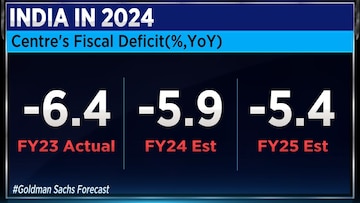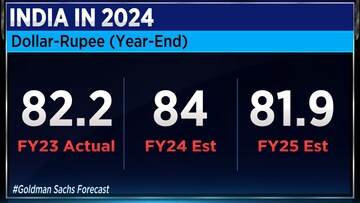Santanu Sengupta, Chief India Economist, Goldman Sachs, on Thursday (November 23) made significant economic projections during his appearance on CNBC-TV18, forecasting a shift in India's economic dynamics and growth patterns in the upcoming quarters. He emphasised the role of private capital expenditure (capex) overtaking government-driven capex in the coming year, asserting that this transition could be instrumental in driving India's GDP growth to a robust 6.5%.
This shift, he argued, could fundamentally reshape India's economic trajectory and potentially foster a more balanced and sustainable growth pattern.
This came days after Reserve Bank of India (RBI) Governor Shaktikanta Das said that India's second-quarter GDP will surprise by coming in higher than estimates. CNBC-TV18also conducted a snap poll, which found that 60% of economists have recently revised their Q2 GDP forecasts to approximately 6.7-6.8%. They cited strong tax numbers, favourable corporate results, and the surprising resilience of the US economy, which grew by 4.9% in the July-September quarter.
In terms of inflation forecasts, Sengupta projected an inflation rate of 5.7% for the ongoing quarter, with expectations for a decline to 5% for the entirety of the current fiscal year. Sengupta's analysis suggested a positive trajectory in investment growth, particularly highlighting the second half of the fiscal year 2023-24 as a potential period for relatively better investment expansion.
Regarding the current account deficit, Sengupta estimated it to be around 2% of the Gross Domestic Product (GDP), expressing confidence that the current account would be well-funded, thus promoting stability in the overall economic landscape.
Sengupta further addressed the recent decision by the RBI to increase risk weights, dismissing its potential macro impact.
He emphasised that while the move had been made, its broader impact on the economy would likely be limited. His comments come at a time when the amount of unsecured loans have growing fast, leading to an increase in
risk weights and, therefore, higher lending rates to slow down the rising risks.
The new regulations entail a 25-percentage-point increase in risk weights for banks and NBFCs, necessitating a higher capital requirement for each loan issued. Specifically, the risk weight on retail loans, covering personal loans and credit card loans, has been upped to 125%, up from 100%.
Anticipating a resurgence in the current quarter's growth, Sengupta highlighted two pivotal factors: increased consumption during the festive season and a concerted effort in government spending. These elements, he argued, would play a pivotal role in revitalising growth and setting a positive tone for the current economic climate.
Looking ahead, Sengupta expressed a belief that the market sentiment would strengthen in the latter half of the fiscal year 2023-24, particularly as investors gain confidence in the Federal Reserve's inclination towards an easing cycle.
Furthermore, Sengupta offered insights into the currency market, suggesting that the rupee might experience an early depreciation in the following year, followed by a subsequent appreciation, potentially reaching 82 against the US dollar in the second half of the year.





